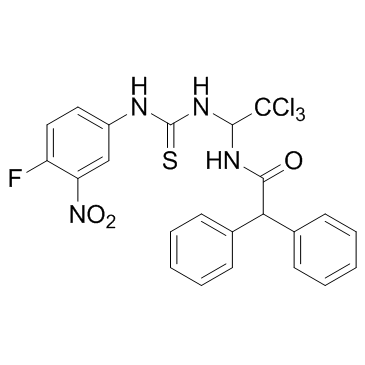905973-89-9
| Name | 2,2-diphenyl-N-[2,2,2-trichloro-1-[(4-fluoro-3-nitrophenyl)carbamothioylamino]ethyl]acetamide |
|---|---|
| Synonyms |
CGK733
2,2-Diphenyl-N-(2,2,2-trichloro-1-{[(4-fluoro-3-nitrophenyl)carbamothioyl]amino}ethyl)acetamide ATM/ATR Kinase Inhibitor UNII:L3DGZ99QYM Benzeneacetamide, α-phenyl-N-[2,2,2-trichloro-1-[[[(4-fluoro-3-nitrophenyl)amino]thioxomethyl]amino]ethyl]- |
| Description | CGK733 is a potent ATM/ATR inhibitor, used for the research of cancer. |
|---|---|
| Related Catalog | |
| Target |
ATM ATR |
| In Vitro | CGK733 (4.2 ng/μL-12.5 ng/μL) enhances taxol-induced cytotoxicity in HBV-positive HCC cells. CGK733 (4.2 ng/μL) accelerates the formation of multinucleated cells and promotes the exit of mitosis in taxol-treated HBV-positive HCC cells[1]. CGK733 (10 μM) causes the loss of cyclin D1 through the ubiquitin-dependent proteasomal degradation pathway in MCF-7 and T47D breast cancer cell lines. CGK733 (0.6-40 μM) shows inhibitory activities against proliferation of LnCap prostate cancer cells, HCT116 colon cancer cells, MCF-7 and T47D estrogen receptor positive breast cancer cells, and MDA-MB436 ER negative breast cancer cells. Moreover, CGK733 inhibits proliferation of non-transformed mouse BALB/c 3T3 embryonic fibroblast cells. In addition, CGK733 (10 μM) inhibits MCF-7 proliferation, and the effect can not be suppressed by pan-caspase inhibition[2]. CGK733 (10 μM) results in 1.6-fold increase in ATM reporter activity in HEK-293 cells[3]. |
| In Vivo | CGK733 (25 mg/kg, i.p.) increases the ATM reporter activity (reports inactivation of ATM kinase activity) compared to control mice, with 2.4-fold, 3.1-fold, and 1.3-fold changes at 1, 4, and 8 hours, respectively[3]. |
| Cell Assay | Cells are seeded in 96-well plates at a predetermined optimal cell density to ensure exponential growth for duration of the assay. After a 24 h preincubation, growth medium is replaced with experimental medium containing the appropriate drug concentrations or 0.1% (v/v) vehicle control. After a 48 h incubation, cell proliferation is estimated using the sulforhodamine B colorimetric assay and expressed as the mean ± SE for six replicates as a percentage of vehicle control (taken as 100%). Experiments are performed independently at least three times. Statistical analyses are performed using a two-tailed Student's t test. P < 0.05 is considered to be statistically significant[2]. |
| Animal Admin | Four to six weeks old athymic CD-1 female mice are acclimatized for at least one week before use. The mice are injected sub-cutaneously with 2×106 D54-ATMR cells in each flank. Tumors are allowed to grow to the size of 100-150 mm3. Mice are injected intraperitoneally with vehicle control (DMSO), CGK-733, KU-55933 (25 mg/kg) or irradiated with 5 Gy to each flank. Bioluminescence is acquired on Xenogen IVIS Spectrum system after injecting 400 μg/100 μL of D-luciferin at baseline (-3h) as well as 1, 4, and 8 hours after drug administration[3]. |
| References |
| Density | 1.5±0.1 g/cm3 |
|---|---|
| Molecular Formula | C23H18Cl3FN4O3S |
| Molecular Weight | 555.836 |
| Exact Mass | 554.014893 |
| PSA | 131.07000 |
| LogP | 6.55 |
| Appearance | light yellow solid |
| Index of Refraction | 1.674 |
| Storage condition | 2-8°C |
